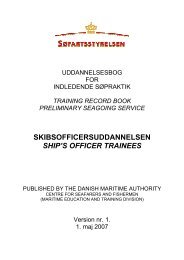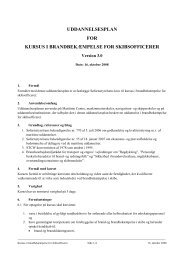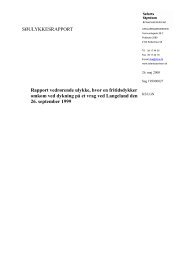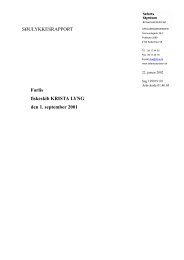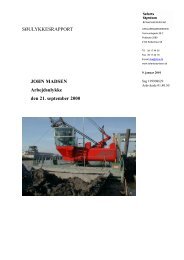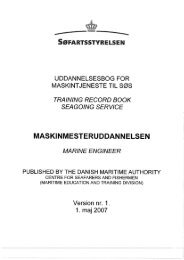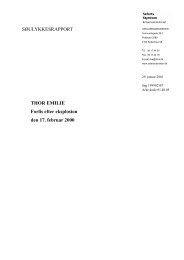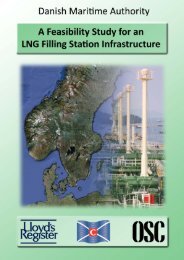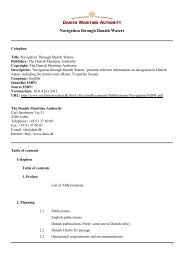Notice from the Danish Maritime Authority B
Notice from the Danish Maritime Authority B
Notice from the Danish Maritime Authority B
You also want an ePaper? Increase the reach of your titles
YUMPU automatically turns print PDFs into web optimized ePapers that Google loves.
1 May 2007<br />
are made to ensure adequate stability in case of cargo shifting and fur<strong>the</strong>r provided that <strong>the</strong> ship has<br />
adequate structural integrity.<br />
3. Prior to loading a bulk cargo which is not a cargo classified in accordance with <strong>the</strong> provisions of <strong>the</strong><br />
IMDG Code, as defined in regulation VII/1.1 but which has chemical properties that may create a<br />
potential hazard, special precautions for its safe carriage shall be taken.<br />
Regulation 7 – Loading, unloading and stowage of bulk cargoes 9)<br />
1. For <strong>the</strong> purpose of this regulation, “terminal representative” means a person appointed by <strong>the</strong><br />
terminal or o<strong>the</strong>r facility, where <strong>the</strong> ship is loading or unloading, who has responsibility for<br />
operations conducted by that terminal or facility with regard to <strong>the</strong> particular ship.<br />
2. To enable <strong>the</strong> master to prevent excessive stresses in <strong>the</strong> ship's structure, <strong>the</strong> ship shall be provided<br />
with a booklet, which shall be written in a language with which <strong>the</strong> ship's officers responsible for<br />
cargo operations are familiar. If this language is not English, <strong>the</strong> ship shall be provided with a<br />
booklet written also in <strong>the</strong> English language. The booklet shall, as a minimum, include:<br />
2.1. stability data, as required by regulation II-1/22 ;<br />
2.2. ballasting and deballasting rates and capacities;<br />
2.3. maximum allowable load per unit surface area of <strong>the</strong> tank top plating;<br />
2.4. maximum allowable load per hold;<br />
2.5. general loading and unloading instructions with regard to <strong>the</strong> strength of <strong>the</strong> ship's structure<br />
including any limitations on <strong>the</strong> most adverse operating conditions during loading, unloading,<br />
ballasting operations and <strong>the</strong> voyage;<br />
2.6. any special restrictions such as limitations on <strong>the</strong> most adverse operating conditions imposed<br />
by <strong>the</strong> Administration or organization recognized by it, if applicable; and<br />
2.7. where strength calculations are required, maximum permissible forces and moments on <strong>the</strong><br />
ship's hull during loading, unloading and <strong>the</strong> voyage.<br />
3. Before a solid bulk cargo is loaded or unloaded, <strong>the</strong> master and <strong>the</strong> terminal representative shall<br />
agree on a plan 10) which shall ensure that <strong>the</strong> permissible forces and moments on <strong>the</strong> ship are not<br />
exceeded during loading or unloading, and shall include <strong>the</strong> sequence, quantity and rate of loading<br />
or unloading, taking into consideration <strong>the</strong> speed of loading or unloading, <strong>the</strong> number of pours and<br />
<strong>the</strong> deballasting or ballasting capability of <strong>the</strong> ship. The plan and any subsequent amendments<br />
<strong>the</strong>reto shall be lodged with <strong>the</strong> appropriate authority of <strong>the</strong> port State.<br />
4. Bulk cargoes shall be loaded and trimmed reasonably level, as necessary, to <strong>the</strong> boundaries of <strong>the</strong><br />
cargo space so as to minimize <strong>the</strong> risk of shifting and to ensure that adequate stability will be<br />
maintained throughout <strong>the</strong> voyage.<br />
5. When bulk cargoes are carried in 'tween-decks, <strong>the</strong> hatchways of such 'tween-decks shall be closed<br />
in those cases where <strong>the</strong> loading information indicates an unacceptable level of stress of <strong>the</strong> bottom<br />
structure if <strong>the</strong> hatchways are left open. The cargo shall be trimmed reasonably level and shall<br />
ei<strong>the</strong>r extend <strong>from</strong> side to side or be secured by additional longitudinal divisions of sufficient<br />
strength. The safe load-carrying capacity of <strong>the</strong> 'tween-decks shall be observed to ensure that <strong>the</strong><br />
deck-structure is not overloaded.<br />
9) Refer to <strong>the</strong> Code of Practice for <strong>the</strong> Safe Loading and Unloading of Bulk Carriers (BLU Code) adopted by <strong>the</strong><br />
Organization by resolution A.862(20).<br />
10) See note 9).<br />
4




